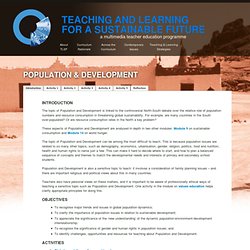

Untitled. Origine Le jeu des chaises a été créé par ITECO. Cette version-ci a été adaptée et actualisée par Corinne Mommen et Chafik Allal, formateurs à ITECO. Objectif Ce jeu permet de prendre conscience de façon vivante du développement inégal de la planète sur le plan économique, démographique et sanitaire. Durée Trente minutes environ. Nombre de participants Douze à 50 personnes. Matériel nécessaire Tableaux de chiffres (ci-dessous).Affichettes des cinq continents : Afrique, Amérique du Nord, Amérique latine, Asie-Océanie, Europe.Autant de chaises que de participants.Autant de cartons verts, de feuilles d’arbres ou d’autre « symbole environnemental » que de participants.Un tableau.
Déroulement du jeu Première étape : répartition de la population mondiale Dans un premier temps, l’animateur du jeu répartit les affichettes des cinq continents sur les murs de la salle. Deuxième étape : répartition de la richesse mondiale Troisième étape : répartition de l’empreinte écologique. Teaching and Learning for a Sustainable Future. Introduction This module introduces some of the major issues – the global realities – that need to be addressed in building a sustainable future.

As such, it serves as a foundation for the more in-depth studies in following modules. It also highlights the interdependence of these issues and how our daily lives, as inhabitants of the world, are related to social, economic and environmental processes. The module demonstrates that changes to the way resources are used are possible, that social and environmental problems can be solved, and that we have the collective capacity to overcome the many problems we face. Objectives. The Story of Stuff Project. The Change Series. In Focus: Congo's Bloody Coltan. Wake Up Call: End the Nightmare of Consumption. Hidden beneath sleek, space-age screens and shining metal, the true cost of our gadgets lurks unseen… Have you ever felt like we're living through a nightmare of consumption?

That you wish you could un-hook yourself and reconnect with a life that is somehow more real and vivid? Then perhaps you're ready to heed Earth's Wake Up Call. Today we live in a time when there is little to no understanding of how the goods we consume and take for granted came into being. Without this we lack the knowledge to understand the true costs of our consumption, and the power to take action. As a result we have become disconnected from Earth - the origin of our health, wealth and all of the 'things' we depend on. Wake Up Call takes us on a fast-paced, animated glimpse of the true costs behind some of our most prized possessions - our electronic gadgets. This new short film for the Gaia Foundation was made by Steve Cutts, the animator who produced this great film. Teaching and Learning for a Sustainable Future. Introduction The topic of Population and Development is linked to the controversial North-South debate over the relative role of population numbers and resource consumption in threatening global sustainability.

For example, are many countries in the South over-populated? Or are resource consumption rates in the North a key problem? These aspects of Population and Development are analysed in depth in two other modules: Module 9 on sustainable consumption and Module 14 on world hunger. Pays du Monde : géographie, tourisme, politique, économie, culture. Villes du Monde jeux gratuits. World Population. Disclaimer Due to their size, the following countries and territories are not represented on the map: Faro Island, Denmark; Gibraltar; Hong Kong SAR; Liechtenstein; Maldives; Monaco; San Marino; Seychelles; St. Helena Island; and Vatican City. Notes The Data Sheet lists all geopolitical entities with populations of 150,000 or more and all members of the UN. These include sovereign states, dependencies, overseas departments, and some territories whose status or boundaries may be undetermined or in dispute. Sub-Saharan Africa: All countries of Africa except the northern African countries of Algeria, Egypt, Libya, Morocco, Tunisia, and Western Sahara.
World and Regional Totals: Regional population totals are independently rounded and include small countries or areas not shown. World Population Data Sheets from different years should not be used as a time series. Sources. Www.edu.gov.on.ca/eng/curriculum/elementary/sstudies18curr.pdf. Lesson Plans - The Canadian Council for Geographic Education Resources. Canadian Geographic Education is pleased to offer teachers ready-to-use lesson plans.

These lesson plans were written by qualified CG Education teachers and are available for the appropriate curriculum within each provincial and territorial jurisdiction. They all reference CG Education published Canadian Standards for Geography and the Scope and Sequence Chart. CG Education plans to add to this collection of lesson plans yearly so that teachers will have a growing source of ideas to draw from. Click here to search all of the lesson plans The Canadian Football League classroom activities Canadian Geographic Education is pleased to bring you 13 new classroom activities that highlight the geography of football. Canada’s Capital: Horizon 2067 Canadian Geographic Education , in collaboration with the National Capital Commission (NCC), is pleased to present a set of bilingual, ready-to-use lesson plans about Canada’s Capital Region for the intermediate level.